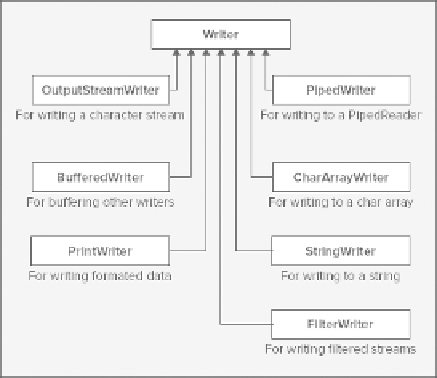Java Reference
In-Depth Information
Of course, the operations with a reader are much more efficient if you buffer it with a
BufferedReader
object like this:
BufferedReader keyboard = new BufferedReader(new InputStreamReader(System.in));
Here, you wrap an
InputStreamReader
object around
System.in
and then buffer it using a
BufferedReader
object. This makes the input operations much more efficient. Your read operations are
from the buffer belonging to the
BufferedReader
object, and this object takes care of filling the buffer from
System.in
when necessary via the underlying
InputStreamReader
object.
A
CharArrayReader
object is created from an array and enables you to read data from the array as though
it were from a character input stream. A
StringReader
object class does essentially the same thing, but ob-
tains the data from a
String
object.
Using Writers
Let's discuss just a few details of the most commonly used of these classes.
The
OutputStreamWriter
class writes characters to an underlying binary stream. It also has a subclass,
FileWriter
, that writes characters to a stream encapsulating a file. Both of these are largely superseded by
the new I/O facilities.
Note that the
PrintWriter
class has no particular relevance to printing, in spite of its name. The
PrintWriter
class defines methods for formatting binary data as characters and writing it to a character
stream. It defines overloaded
print()
and
println()
methods that accept an argument of each of the prim-
itive types, of type
char[]
, of type
String
, and of type
Object
. The data that is written is a character rep-
resentation of the argument. Numerical values and objects are converted to a string representation using the
static
valueOf()
method in the
String
class. Overloaded versions of this method exist for all the primitive
types plus type
Object
. In the case of an argument that is an
Object
reference, the
valueOf()
method just


